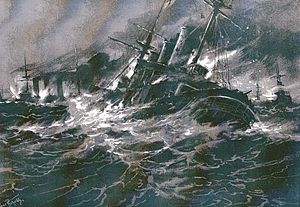| Battle of Coronel | |||||||
|---|---|---|---|---|---|---|---|
| Part of the First World War | |||||||
 Die Seeschlacht bei Coronel, Hans Bohrdt | |||||||
| |||||||
| Belligerents | |||||||
|
|
| ||||||
| Commanders and leaders | |||||||
|
|
| ||||||
| Strength | |||||||
|
2 armoured cruisers 3 light cruisers |
2 armoured cruisers 1 light cruiser 1 auxiliary cruiser | ||||||
| Casualties and losses | |||||||
| 3 wounded |
1,660 killed[1] 2 armoured cruisers sunk 1 light cruiser damaged | ||||||
The Battle of Coronel was a First World War naval battle that led to an Imperial German Navy victory over the Royal Navy on 1 November 1914, off the coast of central Chile near the city of Coronel. The East Asia Squadron (Ostasiengeschwader or Kreuzergeschwader) of the Imperial German Navy (Kaiserliche Marine) led by Vice-Admiral Graf Maximilian von Spee met and overpowered a British squadron commanded by Rear-Admiral Sir Christopher Cradock.
The engagement probably took place as a result of misunderstandings. Neither admiral expected to meet the other in full force. Once the two met, Cradock understood his orders were to fight to the end, despite the odds being heavily against him. Although Spee had an easy victory, destroying two enemy armoured cruisers for just three men injured, the engagement also cost him almost half his supply of ammunition, which was irreplaceable.
Shock at the British losses led the Admiralty to send more ships, including two modern battlecruisers, which in turn destroyed Spee and the majority of his squadron on 8 December at the Battle of the Falkland Islands.
- ^ "Battle of Coronel". World War 1 at Sea - Naval Battles in outline with Casualties etc. naval-history.net. 30 October 2013. Archived from the original on 22 March 2021. Retrieved 4 November 2018.